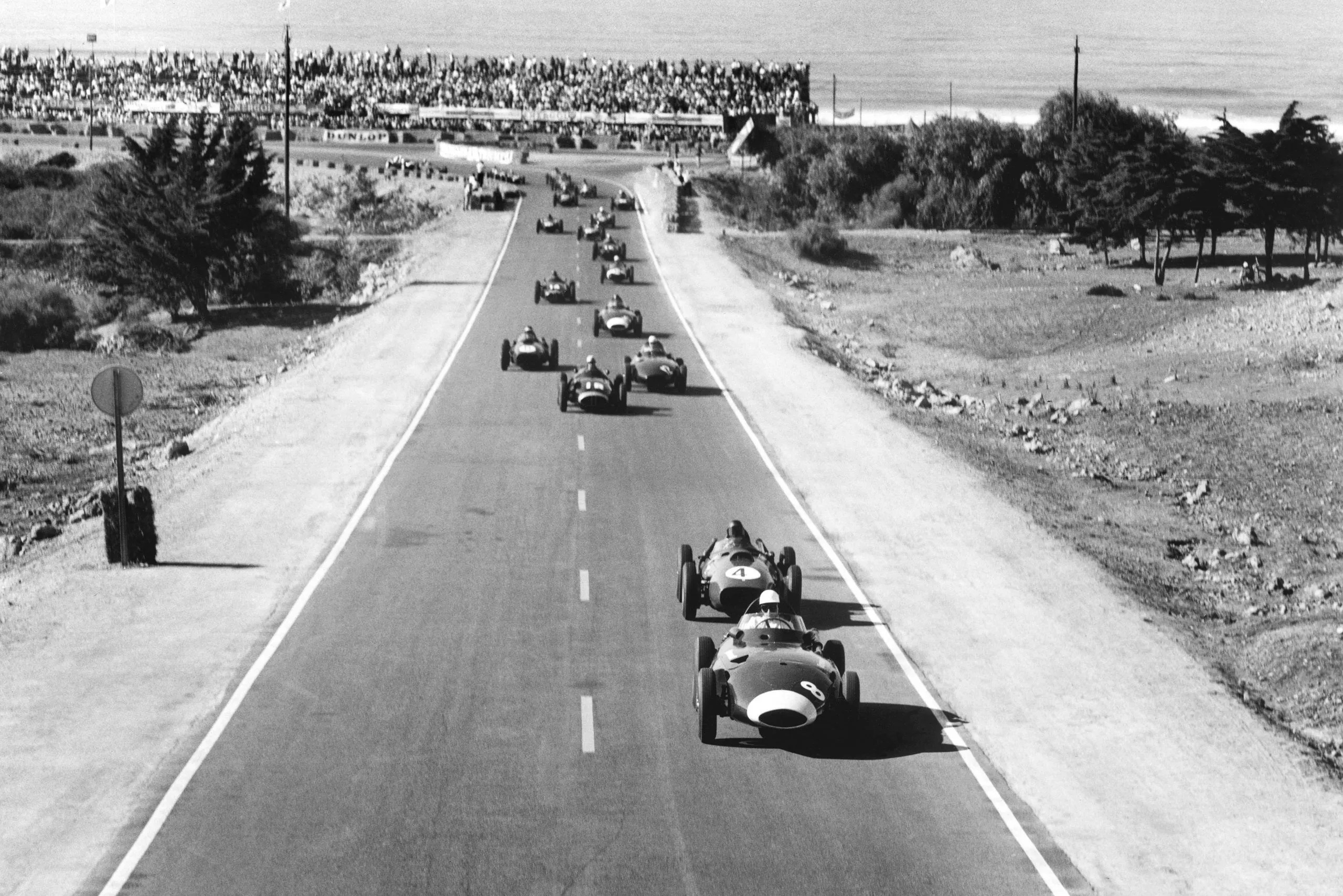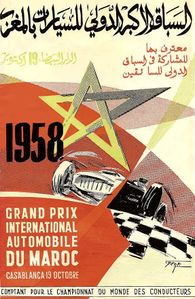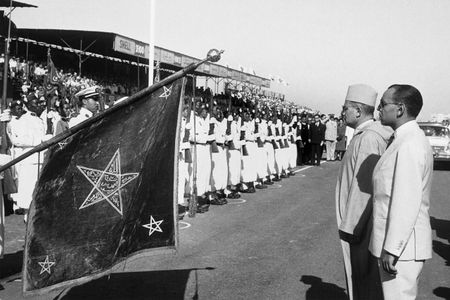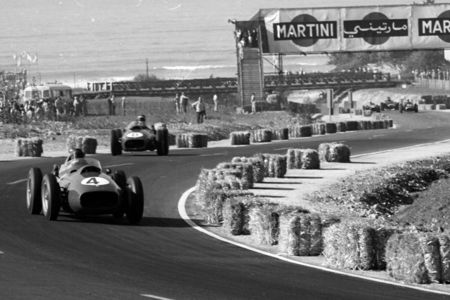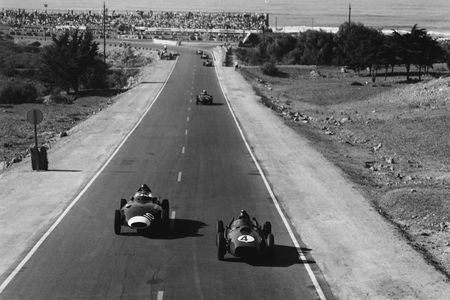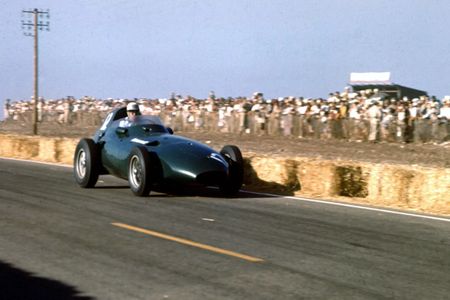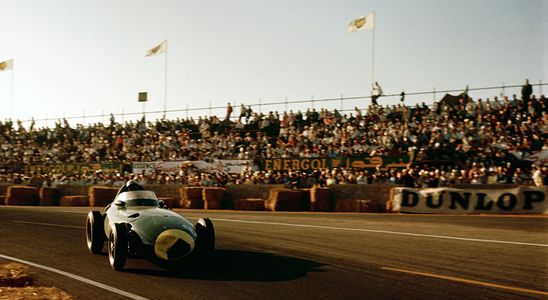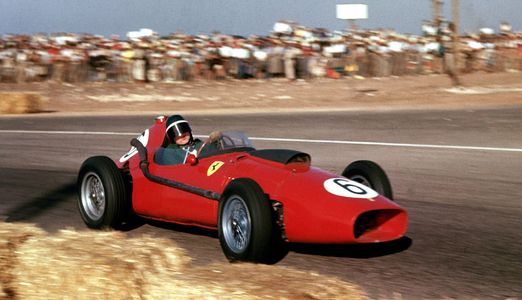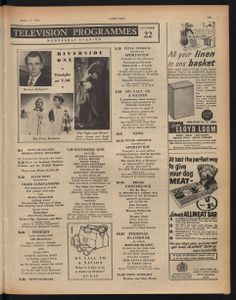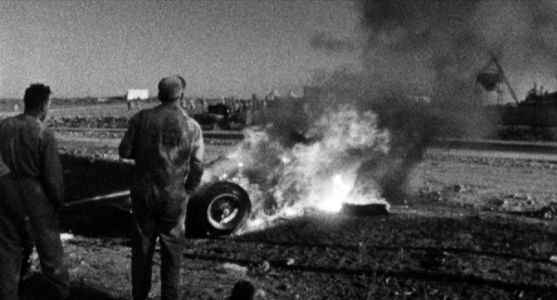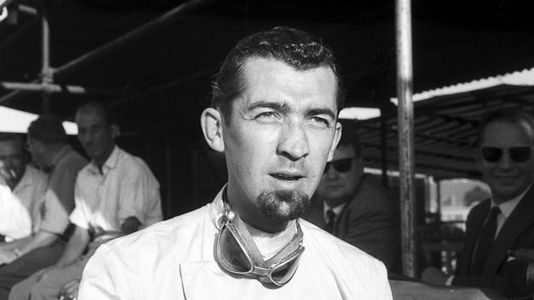1958 Moroccan Grand Prix (partially found footage of Formula One World Championship race; 1958)
The 1958 Moroccan Grand Prix was the 11th and final race of the 1958 Formula One Season. Occurring on 19th October at the Ain-Diab Circuit, the race would ultimately be won by Vanwall's Stirling Moss in controlling fashion. However, Moss' title rival Mike Hawthorn finished second in a Ferrari in his final race before retiring from Formula One, which was enough for the latter to become Britain's first World Champion over Moss by one point. The race is also infamous for the fatal accident of Vanwall's Stuart Lewis-Evans, which contributed to Vanwall's withdrawal from Formula One.
Background
The 1958 Moroccan Grand Prix was the first, and to date, only instance of the event being held as part of the Formula One World Championship.[1] Previously, 12 Moroccan Grand Prix were held, with the 1958 edition also marking the last time it occurred.[2][1] The Ain-Diab Circuit had previously hosted the 1957 edition that was won by Maserati's Jean Behra, but the track would be closed following the 1958 race.[3] The race marked the first time a World Championship event had been held in Africa.[4] Heading into the race, Hawthorn led the Drivers' Championship with 40 points, eight ahead of Moss.[4] To become champion, Moss needed to not only win and post the fastest lap, but also have Hawthorn finish third or lower.[4][2] Meanwhile, Vanwall had already won the Constructors' Championship in the previous event, leading Ferrari 46 to 40.[2]
When Hawthorn arrived at the event, his mood darkened somewhat when he discovered his Ferrari had the number 2 painted on it, which had been used by teammates Luigi Musso and Peter Collins when they suffered their fatal accidents at the French and German Grand Prix respectively.[4] Perhaps to avoid fate, Hawthorn would swap numbers with Olivier Gendebien.[4] In qualifying, the speeds of the Vanwalls and Ferraris were clear, with Vanwall's Tony Brooks already breaking the fastest lap set the previous year, with Hawthorn a tenth of a second behind.[5] Moss initially had trouble setting a fast time, including when BRM's Harry Schell partially blocked him during one of his hot laps.[5] The next day, Moss again suffered issues when his Vanwall's engine failed, taking Brooks' car as the latter had yet to arrive on the circuit.[5] When he did, he took Stuart Lewis-Evans' car, while Lewis-Evans was forced to make do with the spare car.[5] Despite Moss setting faster times in his replacement car, it was Hawthorn who won the pole position, with a time of 2:23.1.[6][5][4][2][1] Moss was second, and happy with this due to the fact he could start his Vanwall at the centre of the front row.[5][4][6][2][1] Lewis-Evans meanwhile would start third out of 25 competitors.[4][5][6][1]
The Race
With the starting order decided, the 1958 Moroccan Grand Prix commenced on 19th October.[6] Moss and Ferrari's Phil Hill made the best starts, and were side-by-side when the reached the pits, Hawthorn languishing in third and Lewis-Evans also losing a few places despite a strong start.[5][4][1][6] Hill continued to pressure Moss, but out-braked himself and ended up an escape road, dropping down to fourth.[5][4] With Hill no longer challenging, Moss began to increase the gap between himself and Hawthorn.[4][5][1][6] Hill however would eventually re-pass Hawthorn for second by lap 8, but encountered the F2 Cooper-Climax cars that Moss had already lapped, thus being unable to close the gap between himself and the Vanwall.[5][1] Despite Hill setting a lap record of 2:23.3, Moss was now ten seconds in front by lap 13, while Brooks began to challenge Hawthorn for third, passing him on lap 17.[5] Moss suffered a setback on lap 18 however, when he collided with lapped Maserati driver Wolfgang Seidel, taking out the Maserati while damaging his Vanwall's nose.[5][6] Nevertheless, he continued his strong pace, setting the fastest lap and leading Hill by 20 seconds.[5][1]
On lap 26, Hawthorn passed Brooks, only for the latter to regain it two laps later.[5][4] However, Ferrari had been planning for this, tasking Hill to pressurise Moss while Hawthorn could steadily maintain third.[4][5][2] The aim was to try and force a breakdown, considering the cars' general unreliability back then.[4] This worked when on lap 30, Brooks pushed too hard and suffered an engine failure.[4][5][2][6] With Lewis-Evans considerably behind, Ferrari could now allow Hill to end his pursuit of Moss, and enable Hawthorn to pass him for second.[5][4][2][1][6] The overtake occurred on lap 39, where as it now stood, Hawthorn would become the World Champion.[5][1] With Moss around 71 seconds in front, he now required Lewis-Evans, who was in fifth, to close the gap and challenge the Ferraris.[5][4] However, Lewis-Evans would suffer his fatal accident on lap 42.[4][5][2][1][6]
Thus, despite Moss continuing to increase the gap over Hawthorn, easily winning and earning nine points in the process, it was the Ferrari driver who became the first World Champion in the end, by one point.[5][4][2][1][6] Hill finished third, with the BRMs of Jo Bonnier and Schell claiming the final points positions of fourth and fifth respectively.[5][6] This would mark Hawthorn's final Formula One event; while he stated that he wanted to go out on top, it is speculated that the death of close friend Collins had also contributed to his retirement.[4][2][1] On 22nd January 1959, Hawthorn would pass away in a road accident, aged 29.[7][2][1]
Death of Stuart Lewis-Evans
On lap 30, the event had already witnessed a major accident involving Gendebien, and the Cooper-Climaxes of Tommy Bridger and François Picard on the Brickyard Corner.[8] This resulting accident saw Gendebien and Picard suffer serious injuries.[8] 12 laps later, Stuart Lewis-Evans was running in fifth, and was required by Vanwall to close the gap so as to challenge the Ferraris and ensure Moss could become champion.[4][5][2][8] Suddenly his Vanwall's engine expired, and worse its rear wheels locked, causing the car to spin off the road, somersault, and crash into trees.[9][4][5][2] The Vanwall suffered a ruptured fuel pipe which ignited and caused severe burns to Lewis-Evans.[2][4][5][9] The driver was able to escape the inferno, but was forced to shield his face and moved away from marshals and firefighters that could have otherwise assisted him.[2][9][4][5]
Vanwall owner Tony Vandervell immediately flew Lewis-Evans to the Queen Victoria Hospital, where he recovered from shock.[9][4] However, the 75% burns he suffered proved too great and he passed away six days later from blood poisoning aged 29.[9][4][2][5] Having started 16 World Championship events, Lewis-Evans finished third twice, at the 1958 Belgian and Portuguese Grand Prix.[8] His small stature yet admirable personality led to him being regarded as "The Little Man with the Big Heart".[8] His fatal accident would have far-reaching consequences for Formula One's future. Firstly, with himself already having suffered from declining health, Vandervell elected to withdraw his team from Formula One out of grief.[2][4][8] Additionally, future Formula One boss Bernie Ecclestone, who was close friends with Lewis-Evans, also left the sport until 1965.[2]
Availability
According to Issue 1,823 of Radio Times, a special 15-minute Sportsview episode reported on the race on 22nd October, with Moss being the reporter.[10][11][12] The broadcast has yet to resurface, though newsreel footage of the race is publicly available.
Gallery
Videos
Images
See Also
- 1953 British Grand Prix (partially found footage of Formula One World Championship race; 1953)
- 1953 Italian Grand Prix (partially found footage of Formula One World Championship race; 1953)
- 1954 British Grand Prix (partially found footage of Formula One World Championship race; 1954)
- 1954 Italian Grand Prix (partially found footage of Formula One World Championship race; 1954)
- 1955 Dutch Grand Prix (partially found footage of Formula One World Championship race; 1955)
- 1955 Italian Grand Prix (partially found footage of Formula One World Championship race; 1955)
- 1955 Monaco Grand Prix (partially found footage of Formula One World Championship race; 1955)
- 1956 Belgian Grand Prix (partially found footage of Formula One World Championship race; 1956)
- 1956 British Grand Prix (partially found footage of Formula One World Championship race; 1956)
- 1956 French Grand Prix (partially found footage of Formula One World Championship race; 1956)
- 1956 Italian Grand Prix (partially found footage of Formula One World Championship race; 1956)
- 1956 Monaco Grand Prix (partially found footage of Formula One World Championship race; 1956)
- 1957 British Grand Prix (partially found footage of Formula One World Championship race; 1957)
- 1957 Monaco Grand Prix (partially found footage of Formula One World Championship race; 1957)
- 1958 British Grand Prix (partially found footage of Formula One World Championship race; 1958)
- 1958 French Grand Prix (partially found footage of Formula One World Championship race; 1958)
- 1958 Italian Grand Prix (partially found footage of Formula One World Championship race; 1958)
- 1958 Monaco Grand Prix (partially found footage of Formula One World Championship race; 1958)
- 2005 San Marino Grand Prix (partially found ITV advert break during final laps of Formula One race; 2005)
- Advanced Driving with Graham Hill (lost ITV motoring series; 1974)
- Angelo Orsi's photos of Ayrton Senna (lost photos of Formula One driver post-crash; 1994)
- Anthoine Hubert and Juan Manuel Correa (partially found FOM footage of fatal Formula 2 crash; 2019)
- Ayrton Senna (partially lost on-board video of fatal Formula One crash; 1994)
- Donkey Does F1 (partially found photos of Shrek character inflatable at Formula One races; 2004)
- F-1 World Grand Prix III (lost build of cancelled Nintendo 64 Formula One racing game; 2000-2001)
- F1 2000 (lost pre-release builds of Formula One game; 2000)
- F1 2010 (lost pre-alpha build of Formula One game; 2010)
- F1 Racing Championship 2 (lost build of cancelled PC/PlayStation 2 Formula One game; 2001)
- Fernando Alonso's 2015 testing accident (lost footage of Formula One test session crash; 2015)
- Grand Prix 3 (lost build of cancelled Dreamcast port of PC Formula One racing game; 2001)
- Grand Prix 4 (lost build of cancelled Xbox port of PC Formula One racing game sequel; 2002)
- Jules Bianchi (lost FOM footage of fatal Formula One crash; 2014)
- María De Villota (lost footage of fatal Formula One crash; 2012)
- McLaren MP4-18 (lost footage of unraced Formula One car; 2003)
- Michael Schumacher (lost photo of Formula One driver post-skiing accident; 2016)
- Neil Shanahan (lost footage of fatal British Formula Ford Zetec Championship crash; 1999)
- Paul Warwick (lost footage of fatal British F3000 crash; 1991)
- Racing Arrows (partially found Formula One TV series; 2001)
- Robert Kubica's 2010 Japanese Grand Prix Q3 lap (lost audio of Formula One qualifying lap; 2010)
- Williams FW15C (partially found footage and lap time information of unraced CVT Formula One car; 1993)
References
- ↑ 1.00 1.01 1.02 1.03 1.04 1.05 1.06 1.07 1.08 1.09 1.10 1.11 1.12 1.13 1.14 Racing News 365 detailing the only Moroccan Grand Prix to count towards the Formula One World Championship. Retrieved 10th Sep '22
- ↑ 2.00 2.01 2.02 2.03 2.04 2.05 2.06 2.07 2.08 2.09 2.10 2.11 2.12 2.13 2.14 2.15 2.16 2.17 2.18 ESPN summarising the race. Retrieved 10th Sep '22
- ↑ Motor Sport detailing the Ain Diab Circuit. Retrieved 10th Sep '22
- ↑ 4.00 4.01 4.02 4.03 4.04 4.05 4.06 4.07 4.08 4.09 4.10 4.11 4.12 4.13 4.14 4.15 4.16 4.17 4.18 4.19 4.20 4.21 4.22 4.23 4.24 4.25 4.26 BBC Sport summarising the race and how it marked an "end of an era". Retrieved 10th Sep '22
- ↑ 5.00 5.01 5.02 5.03 5.04 5.05 5.06 5.07 5.08 5.09 5.10 5.11 5.12 5.13 5.14 5.15 5.16 5.17 5.18 5.19 5.20 5.21 5.22 5.23 5.24 5.25 5.26 5.27 Motor Sport providing a detailed race report. Retrieved 10th Sep '22
- ↑ 6.00 6.01 6.02 6.03 6.04 6.05 6.06 6.07 6.08 6.09 6.10 6.11 Racing-Reference detailing qualifying and race results of the event. Retrieved 10th Sep '22
- ↑ Motorsport Memorial page for Mike Hawthorn. Retrieved 10th Sep '22
- ↑ 8.0 8.1 8.2 8.3 8.4 8.5 Motorsport Memorial page for Stuart Lewis-Evans. Retrieved 10th Sep '22
- ↑ 9.0 9.1 9.2 9.3 9.4 The Crash Photos Database detailing Lewis-Evans' crash and providing photos of it. Retrieved 10th Sep '22
- ↑ BBC Genome archive of Radio Times issues detailing the Sportsview broadcast. Retrieved 10th Sep '22
- ↑ Issue 1,823 of Radio Times listing the Sportsview special. Retrieved 10th Sep '22
- ↑ List of Formula One television broadcasts noting the BBC provided race highlights. Retrieved 10th Sep '22

